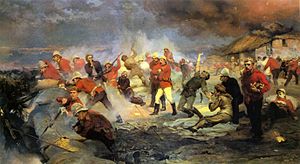George Smith (chaplain)

'Padre' George Smith (8 January 1845 – 26 November 1918), an army chaplain, was a defender of Rorke's Drift during the Zulu War of 1879, an action which saw the awarding of eleven Victoria Crosses.
He was born in Docking in Norfolk in 1845, the youngest of three sons of William Smith (1801–1877), a master shoe-maker who employed two men in his business, and Frances, née Peacock (1805–1876).[2] In 1861 aged 16 he was lodging at an address in King's Lynn in Norfolk where he was working as a railway clerk.[2]

'Padre' George Smith served as a
After the Zulu War he was often referred to as "Ammunition Smith".[2] As an assistant army chaplain, and therefore technically a civilian, Smith was not entitled to receive a campaign medal or other award for his part in the defence. Instead he was offered, and accepted, a position as a regular army chaplain.
After
Padre Smith also served in many posts in the
Depictions and legacy
He is depicted in The Defence of Rorke's Drift (1880) by Elizabeth Thompson and in the identically named painting by Alphonse de Neuville. In Alphonse de Neuville's famous 1880 painting The Defence of Rorke's Drift (above) Padre Smith is depicted to the right of centre (recognisable in his blue tunic and red beard) distributing ammunition to the defenders.[3]
George Smith is honoured at
References
- ^ Victorian war forum
- ^ a b c d e f William M. Lummis, M.C., Padre George Smith of Rorke’s Drift (Norwich: Wensum, 1978), pp 15-45 ISBN 978-0903619219
- ^ a b c Gosling, Chris. The Rev. George Smith and Alphonse De Neuville’s Painting in Sydney, and an Obituary, Anglo-Zulu War Society
- ^ "No. 27165". The London Gazette. 16 February 1900. p. 1078.
- ^ George MacDonald Fraser. Flashman and the Tiger, Harper Collins (1998), page 287
External links
- Padre Smith's account of the Battle of Rorke's Drift
- Padre George Smith on the Rorke's Drift Roll of Honour at the Wayback Machine (archived 29 July 2004)
- The Defenders of Rorke's Drift at the Wayback Machine (archived 7 April 2004)
